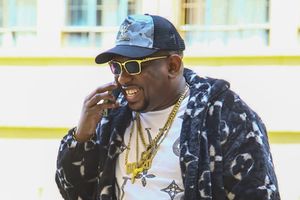Inside Sagana home for elderly women

Some of the elderly women at St Mary's Village, Sagana, bask in the afternoon sun on April 28, 2022.
What you need to know:
- At any given time, three sisters are in charge as per the policy of the Nirmala congregation.
- They work round the clock and are assisted by 11 part-time workers, who operate in shifts.
From the main road, the murram path leading to St Mary’s Village in Sagana is quiet, empty and lonely. After about a kilometre, a small signage at a black gate shows I have arrived at my destination.
A nun instructs two women outside an office who constantly nod, while some elderly women sit on benches on the verandahs. When she notices my presence, she walks towards me and we quickly exchange pleasantries.
She leads me into a chapel where five women welcome me with four ululations as is the Agikuyu custom when a girl is born. Behind their sad smiles are sunken eyes bearing pain of abandonment.
Hellen Wanja, 90, has stayed at St Mary’s for the past seven years. She is one of 39 women from various parts of the country who call the village located 94 kilometres from Nairobi in Kirinyaga County, home.
“Mimi ni fresh kabisa (I am very fresh),” she says, a small smile plastered on her face.

Ms Hellen Wanja, 90, at St Mary's Village Sagana on April 28, 2022.
Ms Wanja, like most of the other women at the home, has no family to care for her. She was brought from Nyeri by a woman she met in church, named Georgina. At first, Georgina rented Ms Wanja a house and ensured that she lacked nothing. Unfortunately, after two years, Georgina’s elderly mother fell ill and she could no longer afford to care for both women.
“I have a sister and a brother but was not blessed with any children. Before I met my rescuer, I had no life. I lived in a mud house that had crumbled and I was struggling with an untreated foot with nothing,” she recalls.
Emmah Wanjiku, 65, another resident, came to the home in 1996. Wanjiku, who is paralysed on her right side, was brought to the home by her church members after her mother, who was her carer, died. Unlike Ms Wanja, she has a son, who is too poor to care for her. Wanjiku, who is very bubbly, says the years have been good and she is grateful to have a place to call home.
“My son lives nearby in Sagana, whenever I miss him, I always call and he visits me which makes me very happy,” she says.
Georgina used to visit Ms Wanja but has since fallen ill and sends her children instead.
Ms Wanjiku and Ms Wanja are among the few who get visitors, most of the women don’t. Once they are dropped off, they remain there until their last breath and are buried at a cemetery in the home.
History
St Mary’s Village was founded in 1974 by James Chiomo, an Italian Consolata missionary, to serve blind, deaf and elderly women who were shunned by the community. Since it opened, Catholic sisters from the Society of Nirmala Dasi Sisters in Kerala, India, have been under contract to run the home.
At any given time, there are three sisters in the village as per the policy of the Nirmala congregation. Of the three, one must be a registered nurse. They work round the clock and are assisted by 11 part-time workers, who operate in shifts.
Thressia Maliakkal, the sister in charge of the village, first came to Kenya in 1991.
“The biggest challenge I experienced back then was language barrier. I was posted up north in Maralal and, of course, we could not communicate. In Marsabit, they didn’t wear any clothes but were very lovely people and I adjusted quickly,” she says.

Sister Thressia Maliakkal, who is in charge of St Mary's Village, Sagana, on April 28, 2022. She first came to Kenya in 1991 from South India.
The nun, who speaks four local languages: Rendile, Samburu, Kiswahili and Kikuyu, says the secret to learning a new language is engaging young children.
Sr Maliakkal got her calling to work for the neediest in society at a young age. She attended catholic school where she was acquainted with the work of priests and nuns. After catechism teachings, she chose to heed the calling, despite her father’s reluctance. He wanted her to get a career and marry like her siblings had done.
The jovial, easy going nun has worked in the village for five years.
A day in the home
Sr Maliakkal reveals that the women have a routine to ensure smooth running of the home.
Except for those who are bedridden, the women wake up at 5am and prepare for morning Mass, which ends at 6.30 am. They lead the Mass themselves and, as Sr Maliakkal says, it is always very vibrant.
“Emmah is usually the lead chorister and she is very talented,” she adds.
At 7.30 am. breakfast is served and the women get a jug of porridge each to drink throughout the day. At 8 am, the hard work starts. Work is subdivided to increase efficiency. The sisters move all the bedridden women outside, give them their baths, while two workers clean the rooms that takes about four hours. Elsewhere in the home, one worker starts preparing lunch while another hand washes all the clothes.
At 12 pm, lunch is served. Feeding the immobile women takes about two hours. After lunch, some choose to go pray in the chapel, but a majority sleep. At 2.30 pm, we again bring the bed-bound out to bask in the sun until 4 pm when supper is served. After 6 pm, everyone retires.
Funding
The village was previously supported by well-wishers from Italy, owing to the contacts of the Italian fathers who have all since died. From 2015, it has been relying on donations from the local community and once a year, on the second Saturday of March, which is called St Mary’s Day, the village invites different people and entities to fundraise.
“We farm our own crops and we keep livestock,” says the village director, Father Michael Mutinda. “Our biggest challenge is money to buy medicines and assistive technologies like wheelchairs, and to pay workers’ salaries.”
Wellness
Ms Catherine Kihato, a counsellor, has worked with the women of Sagana for over 10 years. A native of the area, she holds at least one group counselling session every month and private meetings, depending on the need, which is usually daily. Ms Kihato says most of them are bitter.
“Many of the women harbour a lot of anger for being treated badly, rejected and neglected. I encourage them to cultivate a positive outlook, to forgive and move forward from their past experiences,” she says.
Fr Mutinda links the high cases of depression and hypertension to the bitterness and anger in the women.
Aside from the counselling sessions, the women engage in weaving baskets, knitting and cleaning the compound to keep themselves preoccupied and prevent them from drowning in thoughts.
Ms Kihato says she is saddened that the African concept of caring for elderly is quickly dying.
“In the past, there was always someone who was left behind to look after old parents; we should revive that culture,” she adds.
Fr Mutinda insists that more needs to be done for the elderly.
“I don’t understand how one mother can nurse five children, but the children cannot come together and care for their parent. Families should set aside a budget for old parents and those who feel they are incapable should look for care homes as is the case in developed countries. Taking care of the elderly in our community is not an option, it’s a duty,” concludes Fr Mutinda.





